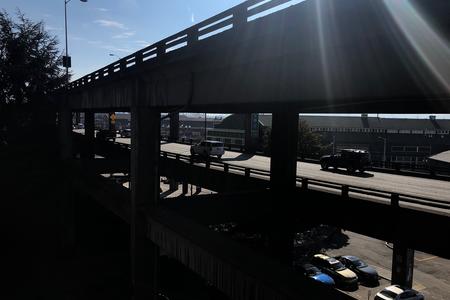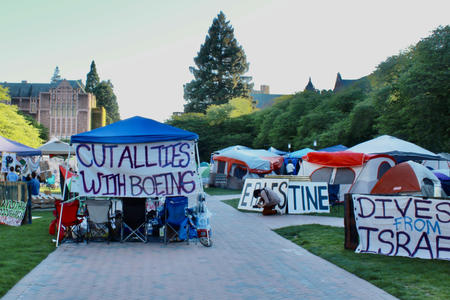This will be the longest planned highway shutdown in Seattle history and will tie up commuters by displacing approximately 90,000 viaduct trips per day. The new Bertha-bored tunnel will not yet be open.
Laura Newborn, project spokesperson with the Washington State Department of Transportation, reminds us that the viaduct replacement is about safety. The structure suffered earthquake damage in 2001 and has been slowly sinking. “It’s not about making traffic better,” Newborn says. Now they tell us.
In the short term, it will make traffic much worse. The crunch should be alleviated when the Highway 99 tunnel opens after the predicted three-week interregnum following the viaduct's closing. They won’t be charging tolls at first, so the new tunnel should absorb many of those 90,000 vehicle trips, and perhaps more, until tolling is instituted. And when tolling does go into effect — not before summer, Newborn says — no one really knows what the effect will be. Certainly better than a closed tunnel, but not everyone will want to pay. So the surface streets might be clogged with more drivers on an ongoing basis.
The Period of Maximum Constraint — or the #SeattleSqueeze for those trying to make it seem like a quirky local tradition — will last for much longer than those first three challenging weeks. The Seattle Department of Transportation says it is “the new normal” and will last the next five years.
The viaduct shutdown is just the beginning because that will be followed by other big, sometimes messy and simultaneous projects, like kicking buses out of the downtown bus tunnel to make it for light rail only. That will put 800 more bus trips a day onto already clogged surface streets. There’s also the process of tearing down the viaduct and replacing it with a new street/boulevard/highway along the waterfront, plus other waterfront makeover projects. Oh, and there’s the Washington State Convention Center expansion along Interstate 5. That’s on top of other ongoing work, like Rainier Tower Two (the Kinky Boot) or the major work at Montlake for the Highway 520 expansion.
Newborn says that while this month’s viaduct closure is unprecedented, so is what is happening in Seattle: unprecedented numbers of cranes, unprecedented growth. And she’s right. The Period of Maximum Constraint is the inevitable result of a city whose desire for growth is part and parcel of a civic masochism: we will be big and world class, even if it hurts!
Major disruptions are not, however, unprecedented. Early Seattle engineers reveled in remaking the landscape. The legendary R.H. Thomson “as an engineer was inclined to remove a hill simply because it was there…,” wrote historian Murray Morgan. Seattle went through numerous land regrades, mainly to benefit transportation and development, but the resulting displacements were mostly an inconvenience for residents and business, not commuters. Still, it was part of the city’s think-big pattern set in the latter half of the 19th century.
The building of the Lake Washington Ship Canal to connect Puget Sound with Lake Union and Lake Washington was also extraordinary and split the city in half. Again, it was meant as an unprecedented improvement to transportation — a big dig to help shipping, industry and the maritime economy. Creative ways were developed to ease some inconvenience. Historian David Williams, who has written about the regrades and the ship canal, says that in the early 1920s floating pontoon bridges for pedestrians were laid at Montlake at 23rd Avenue so tens of thousands of Seattleites could attend events at Husky Stadium until a permanent bridge could be finished.
That kind of creative solution has to come into play when major disruptions occur. And, sometimes, they’ve happened by accident, not planning. For example, in 1978, a freighter named the Chavez slammed into the West Seattle Bridge in the wee hours while heading up the Duwamish, partially because of errors by the 80-year-old pilot guiding it through. The drawbridge was permanently stuck in the open position. It took six years before the unusable bridge was replaced in 1984 and, fortunately, the federal government was persuaded to pay much of the cost. Rolf Neslund, the errant pilot, paid a great price too: he was later murdered by his wife, but that’s another story.
West Seattle traffic was diverted onto a smaller, lower existing bridge or rerouted through South Seattle and the industrial district. Spokane Street and the viaduct were kind of a mess at first. “West Seattle Motorists Struggle Through Giant Jam,” said a Seattle Times headline. But folks adjusted and the jams eased and were never as bad as feared, nor bad by today’s standards. A half-hour backup was unusual in the late ’70s. Today, they are routine. Still, it was a massive headache for many people at the time.
Another surprise was the sinking of the old Lacy V. Murrow I-90 floating bridge in 1990 after a windstorm sloshed water into its pontoons. The new I-90 bridge next to it was not yet open, so the Evergreen Point bridge (State Route 520) was for a time the only way to cross the lake. “Buses Ride to Rush Hour Rescue,” a headline read. The road shoulders on I-5 were opened to transit between downtown and the 520 off-ramp to help buses get through the snarls. The sinking led to a major push for carpools and transit use. People again adjusted their commutes, partly thanks to the bridge's sinking being such a big story that everyone knew to avoid driving across or around the lake if at all possible, which kept traffic volumes lower. Booming employment at companies like Microsoft was making crossing the lake unnecessary for a growing number of Silicon Forest suburbanites. Further growth and changing commuting patterns have spurred light rail across the lake on I-90, and should be up and running in 2023.
For the Period of Maximum Constraint, transportation officials are hoping for major and permanent changes. The city consists of eggs being broken to make a less-auto-centric metropolitan omelet. In other words, rideshares, carpools, pedestrian and bike options, road tolls, congestion pricing, rail and bus transit of all kinds, and passenger ferries are options we need to use and grow. It will not be pretty or fun, but barring economic collapse, North Korean missiles or natural disaster, this is what the future looks like. If you are miserable on the city streets now, failure to adapt won’t make you happier.
SDOT is responding: more transit, better real-time data for commuters, new dedicated bus routes to speed commuting in and out of downtown, improvements to transit stations, special loading zones for e-cargo bikes, Ubers and Lyfts. Hopefully, a city of “creatives” will get creative about this. One of Bellevue’s early visionaries, James Ditty, hoped for zeppelin service between the Eastside and Seattle. Has its time come? More gondolas? Flying cars? Certainly, more passenger ferry service on Puget Sound and lakes is an option in a geography that itself provides constraints — and opportunities.
For Seattle to swallow the bigger omelet, we’re going to have to change our diet dramatically, and five years of pain might do it. Or it might create backlash. Already some are referring to the upcoming period as the Jenny Jam, after Mayor Jenny Durkan, who may take the blame simply because she’s in charge at City Hall. We’re a city that can dump a mayor for not filling potholes or salting the streets in a snowstorm.
There is likely to be lots of finger-pointing down the road (a very clogged and gridlocked road). But adapting is our best survival strategy.






